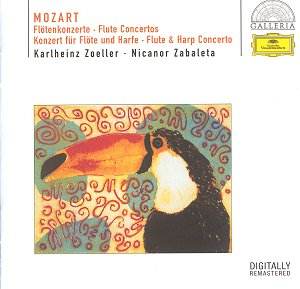Wolfgang Amadeus MOZART (1756-91)
Flute Concertosa - No. 1 in D, K313/285c; No. 2 in D, K314.
Concerto for Flute and Harp in C, K299/297cb.
 Karlheinz Zöller (flute);
bNocanor Zabaleta (harp); aEnglish Chamber
Orchestra/Bernhard Klee; bBerlin Philharmonic Orchestra/Ernst
Märzendorfer.
Karlheinz Zöller (flute);
bNocanor Zabaleta (harp); aEnglish Chamber
Orchestra/Bernhard Klee; bBerlin Philharmonic Orchestra/Ernst
Märzendorfer.
Recorded aDecember 1972, Watford Town Hall, bOctober
1962, Berlin.
 DG Galleria 469 553-2
[ADD]
[74.04]
DG Galleria 469 553-2
[ADD]
[74.04]
Crotchet
AmazonUK
AmazonUS
Amazon
recommendations

Mozart's concertos involving the flute make for gracious, life enhancing
listening: this despite the composer's stated dislike for the instrument.
The finale of the first concerto (K313/285c), for example, is civility
itself, as gallant a Tempo di Menuetto as one can find. Here, as elsewhere
on this disc, Karlheinz Zöller is a musical and able guide. The performances
of both of the solo concertos (originally on DG 2530 334) triumph over the
slightly over-reverberant recording to communicate to a large extent the
inner life of these pieces. One must be prepared to re-enter an earlier world
of performance practice, however. The textures of the Adagio ma non troppo
of the first concerto are muddied by a certain heaviness of orchestral string
tone, made all the more frustrating by the fact that the tempo seems near
ideal.
Whilst Zöller can nevertheless provide much enjoyment by virtue of his
innate musicality, he cannot rescue the over-long cadenza to the first movement
of the second concerto (by R. Müller-Dombois), guaranteed to stretch
the patience of all but the most ardent of Herr Zöller's fans.
Ironically, the Flute and Harp Concerto, recorded a decade earlier (issued
on SLPM138853), seems lighter and truer to the freshness at the heart of
any true Mozart performance. Listen to the violin articulation during the
opening tutti, for example. But what distinguishes this performance from
the solo concertos the sheer joy of the music making. The soloists interact
superbly with each other; the phrasing in the Andantino is a delight and
the cadenza in the concluding Rondeau (Reinecke's) is just the right length.
At mid-price, one has to balance whether it is worth the outlay for, basically,
the Flute and Harp Concerto alone. Of modern performances (if not with exactly
the same coupling), Emmanuel Pahud and the Berlin Philharmonic under Abbado
in the first concerto (who are joined by Marie-Pierre Langlamet for the Flute
and Harp Concerto) provide an excellent, if dearer, alternative (EMI CDC5
57128-2). Galway (with Robles, the Academy of St Martin in the Fields under
Marriner and offering exactly Zöller's coupling) is ever musical and
fresh (RCA Red Seal 09026 68256-2).
By the way, why does DG spell Zöller 'Zoeller' on the front cover and
then 'Zöller' everywhere else? This spoils the otherwise perfectly
acceptable presentation.
Colin Clarke

